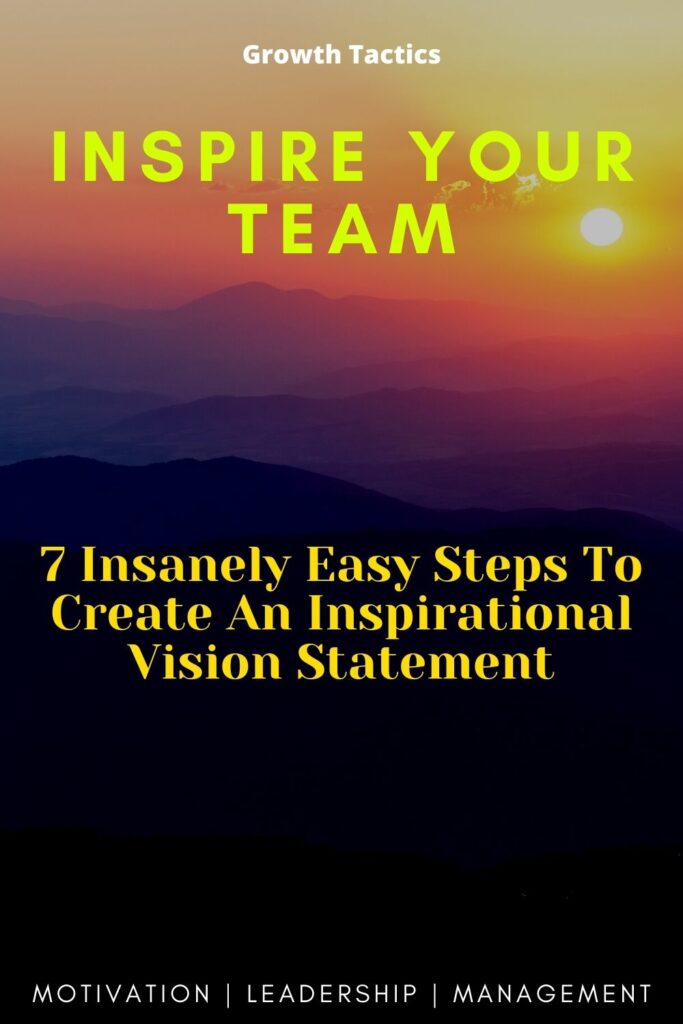A leader needs to offer direction to those within their circle of influence and control. In this article, you will learn the easy steps to create a vision statement to help give direction and give your team something to strive for. Also contained in this article are inspirational vision statement examples from famous companies and personal vision statement examples to help guide you.
This statement helps teams stay on track to reach goals within the work area. It’s great to get members of your team to help construct a vision statement with you. The more the team helps, the more they will buy into the statement and make it a reality.
Creating an inspiring vision statement may seem like a daunting task, but it’s not so hard when you break it down into chunks. Using the steps contained in this article will make your job of writing a vision statement a lot easier.
Jump To Section
How Do We Define Vision?
To create a vision statement, you need to first understand what vision is and how to apply it to your situation.
I define vision as where you want a company, organization, team, or yourself to be in the future. It is how you envision the future. Not the negative aspects of what you think the future might hold, but the positive view of where you want the future to be.
Vision vs Mission Statement
It is common for people to be confused about the difference between a vision statement and a mission statement. Both statements are essential for the success of a company or organization, but they serve different purposes.
A mission statement defines the company or organization’s purpose, values, and objectives. It explains the company’s present situation, what it does, and who it serves. A mission statement should be concise and straightforward, focusing on the company’s current operations.
On the other hand, a vision statement is a long-term statement of where the company or organization wants to be in the future. It focuses on the company’s aspirations, goals, and direction. A vision statement should be inspiring, motivational, and future-oriented.
For example, using the cabinet-making company mentioned earlier, their mission statement might be, “We will create quality cabinets at a reasonable price, with minimal waste, maximizing customer satisfaction.” This statement focuses on the company’s current operations.
However, if you were starting a cabinet company from scratch, your vision statement might be, “To become the leading cabinet manufacturer in the industry by creating quality cabinets at a reasonable price, with minimal waste to maximize profits.” This statement focuses on the company’s future direction and aspirations.
In summary, a mission statement is focused on the present, while a vision statement is focused on the future. Both statements are important for a company’s success and should be carefully crafted to communicate the company’s purpose and aspirations.
7 Easy Steps to Create a Vision Statement

Step 1: Think about your goals.
Your goals are the heart of your statement and therefore should be the first consideration when writing your vision statement.
Where do you see your work area, the company, or yourself in the next five years? How about the next ten years? The answers to these questions are very important in creating a vision statement.
Your statement will be a guide to help you achieve your goals and keep you and your team on track to reach them. Brainstorm a few goals or your view of where you see yourself, your team, and your company in the future. Write down as many details as you can think of. The more details you think of, the better.
Step 2: Know the values of the company or organization.
What values and ethics do you have? What values does the company have? These play a big part in what your vision is and how you want to achieve it. Sometimes we get so focused on our goals that we lose who we are in our pursuit of them. Therefore, ethics and values should play a huge role in your statement.
When you write a vision statement it should be a constant reminder of who you are and what you stand for. Not only to you and your team but also shows everyone else what you stand for.
Step 3: Build on the mission of your team.
Your statement needs to be relevant to your team and what you all do for the company. If you stray too far from the mission of the team, your goals will be unattainable or not of value to your team. Don’t try to change the world with your statement, just try to make your world better. It should be a guide for where you want your team to be in the future.
Your team’s mission should guide your goals for your team and also should guide you when you create a vision statement. For example, if you manage the customer service department in the organization, your goal probably shouldn’t be to have the best quality products. That should be another department’s goal, but your goals should be things within the control of you and your team.
Step 4: Keep it simple but concise.

You want your statement to be very concise and to the point but also as short and simple as possible. The simpler and shorter your statement is, the easier it is for people to remember and internalize. If you write a lengthy vision statement, it can get confusing and can be very hard for people to remember. Try to keep it to one or two sentences. Just don’t make it so small that it loses all its meaning.
Step 5: Think about the future.
You can’t predict everything that will happen but have some foresight when you create your statement. You want to account for changes that you know are coming down the line within the company, your department, or in your life. If you do not, you might be redoing your statement very soon because it may no longer be relevant. You want your statement to be something that can be a guiding principle for a long time.
Step 6: Consider your timeline.
How far out do your goals go? How long before you can reach these goals? You want your objectives to be within reach but still require work to get there. Don’t make it something so easy that you achieve your goals within a short amount of time. But don’t make it something that is never achievable within your organization. Think 3, 5, or 10 years down the road.
Step 7: Put it all together to create your vision statement.
Putting it all together, structure one or two sentences that encapsulate your goals specific to your work area and the mission of your team. Make sure your values are showcased in your statement. Try to simplify it as much as possible without losing your message. Once you have your statement tuned up, read it out loud a few times to see how it sounds. If it’s hard to read, it may be hard for people to remember, and you may want to reword it.
Tips for a Strong Vision Statement
Don’t Be Afraid to Review and Revise
Reviewing and revising your vision statement is an essential part of ensuring that it remains relevant and effective. As your company grows and evolves, your goals and priorities may change, which means that your vision statement needs to be a living document, reflecting these changes. Regularly reviewing and revising your vision statement can help your organization stay focused and motivated, and can ensure that everyone is working towards the same goal.
When reviewing your vision statement, ask yourself whether it still reflects the aspirations and values of the organization. Consider whether it is still relevant to your customers, stakeholders, company culture, and employees. Think about whether it is still achievable and whether it reflects the long-term goals of the company.
If you find that your vision statement is no longer effective, it may be time to revise it. This could involve updating the language or tone of the statement, or it could involve a complete overhaul of the statement to reflect the changing needs of the company.
When revising your vision statement, involve your team and stakeholders in the process. Solicit feedback from employees, customers, and other stakeholders to ensure that the revised statement resonates with everyone. Make sure that the revised statement is clear, concise, and inspiring, and that it reflects the values and aspirations of the company.
Be Authentic to Yourself In Your Statement
Authenticity is an essential requirement for a successful vision statement. An authentic vision statement outlines the true values and beliefs of a company and differentiates it from other organizations. It should not be a generic statement that could apply to any business, but should instead capture the unique qualities and aspirations of the company.
An authentic vision statement is a powerful tool for aligning the values and beliefs of the company with those of its stakeholders, including employees, customers, and partners. It provides a clear direction for the company and helps to establish a sense of purpose and meaning for everyone involved. It can also inspire and motivate people to work towards a common goal and to achieve great things.
To create an authentic vision statement, it is essential to involve stakeholders in the process. This includes employees, customers, and partners who are invested in the organization’s success. Through a process of consultation and collaboration, it is possible to identify the core values and beliefs that underpin the organization’s culture and purpose.
Once these values and beliefs have been identified, they can be expressed in a clear and concise statement that captures the essence of the organization’s vision. The statement should be inspiring and aspirational, reflecting the company’s long-term goals and aspirations. It should also be authentic, reflecting the unique qualities and values of the organization.
Keep It Flexible
Keeping a vision statement flexible is critical to ensuring its long-term effectiveness. A company’s vision should be dynamic and able to adapt to changes in the marketplace, shifts in customer demands, and new innovations in technology.
As a company evolves and grows, its vision may need to be revised to reflect new goals and priorities. For example, if a company expands into a new market or introduces a new product line, its vision may need to be updated to reflect these changes. By regularly reviewing and updating the vision statement, a company can ensure that it remains relevant and aligned with its long-term goals.
Another benefit of keeping a vision statement flexible is that it can help to foster a culture of innovation and creativity within the organization. When a company’s vision is viewed as a dynamic and evolving concept, employees are more likely to feel empowered to suggest new ideas and approaches to achieving the company’s goals.
To keep a vision statement flexible, it is important to establish a process for reviewing it on a regular basis. This may involve gathering feedback from stakeholders, conducting market research, and assessing the company’s performance against its goals. Based on this information, the vision statement can be updated as needed to ensure that it remains aligned with the company’s long-term objectives.
In summary, keeping a vision statement flexible is essential for ensuring its long-term effectiveness. By regularly reviewing and updating the statement, a company can adapt to changes in the marketplace, foster a culture of innovation, and stay aligned with its long-term goals.
Utilize Inclusive language
Inclusive language is an important aspect of creating a vision statement that reflects a company’s commitment to diversity and inclusion. Using language that includes all stakeholders, such as employees, customers, and partners, can help to create a sense of belonging and ensure that everyone feels valued and included.
By using inclusive language, a company can demonstrate its commitment to diversity and inclusion, which can have a positive impact on its reputation and brand image. It can also help to attract and retain a diverse range of talent, as employees are more likely to feel supported and empowered in a workplace that values diversity.
When crafting a vision statement, it is important to consider the language used and whether it is inclusive or exclusive. This may involve reviewing the statement to ensure that it does not use language that could be interpreted as discriminatory or insensitive.
To make a vision statement more inclusive, companies can use language that is gender-neutral, avoids stereotypes, and acknowledges the contributions of all stakeholders. For example, instead of using language that assumes a specific gender or demographic, such as “he” or “she” or “man” or “woman,” use gender-neutral terms like “they” or “person.”
In addition, companies can use language that acknowledges the diversity of their stakeholders, such as “customers from all backgrounds” or “partners of all ethnicities.” This can help to create a sense of inclusivity and demonstrate a commitment to diversity.
Live the Statement
“Living it out” means that the vision statement is not just a statement of words, but a guiding principle that drives the company’s actions and decisions. To ensure that the vision statement is meaningful, it must be integrated into the day-to-day operations of the company. This requires a commitment from all levels of the organization, from top leadership to front-line employees.
To make the vision statement a reality, it is important to align all aspects of the company’s operations with the statement. This can include everything from product development and marketing strategies to employee training and performance evaluations. All decisions and actions should be evaluated against the vision statement to ensure that they are in alignment with the company’s long-term goals and aspirations.
Using the vision statement as a guide for decision-making can also help to ensure that the company remains focused on its core values and purpose. When faced with difficult decisions or competing priorities, referring back to the vision statement can help to provide clarity and direction.
Ultimately, living out the vision statement requires a commitment to continuous improvement and a willingness to adapt to changing circumstances. By making the vision statement a living, breathing part of the organization, the company can ensure that it remains focused on its long-term goals and aspirations, and stays true to its core values and purpose.
Company Vision Statement Examples

McDonald’s Vision Statement
“To be the best quick service restaurant experience. Being the best means providing outstanding quality, service, cleanliness, and value so that we make every customer in every restaurant smile.”
Nike Vision Statement
“Bring inspiration and innovation to every athlete* in the world. (*If you have a body, you are an athlete.)”
IKEA Vision Statement
“Our vision is to create a better everyday life for many people.”
Patagonia Vision Statement
“Build the best product, cause no unnecessary harm, use business to inspire and implement solutions to the environmental crisis.”
Disney Vision Statement
“To make people happy.”
Microsoft Vision Statement
“Empower every person and every organization on the planet to achieve more.”
Ford Vision Statement
“People working together as a lean, global enterprise to make people’s lives better through automotive and mobility leadership.”
Honda 1970 Vision Statement
“We will destroy Yamaha.”
For more examples see 17 Truly Inspiring Company Vision and Mission Statement Examples.
Personal Vision Statement

Is it Only for Businesses? No!
A vision statement is a powerful tool that can be utilized not only in the business world but also in your personal life. By creating a personal vision statement, you can gain clarity on your goals and aspirations, and use it as a guide to lead you toward your desired future.
Just like in business, a personal vision statement describes your purpose and direction. It serves as a compass to guide you through your journey to become the best version of yourself. It is a short statement that captures your core values, beliefs, and goals, and helps you stay focused on the big picture.
Creating a personal vision statement involves a process of self-discovery, reflection, and goal-setting. It requires you to identify what truly matters to you and what you want to achieve in your life. By defining your vision, you can create a roadmap to reach your goals and live a fulfilling life.
In summary, creating a personal vision statement can be a transformative experience that can help you to gain clarity, focus, and direction in your life. It is a powerful tool that can guide you toward achieving your goals and becoming the best version of yourself.
Personal Vision Statement Examples
“Be the best leader I can be, always making those around me better.”
“Champion level athlete entering a professional career as an accomplished honor graduate with a Bachelor of Science Degree in Chemistry.”
“A proud parent that successfully raised my children to be productive members of society while managing a successful professional career.”
“Be a kind, supportive person, always caring for those around me.”
“Successful engineer with a great company making more than 6 figures a year.”
How to Use Your Statement.
Now that you know how to create a vision statement of your own, how do you use it?
When your vision statement sounds good, it’s time to present it to the world. Your vision statement should guide your department. Therefore, it should be displayed where all can see. Preferably places where most of your team will see it daily. If you send a lot of emails, you can put your vision statement after your signature block. The most important part is making sure your team believes in the vision. If they believe, they will do everything they can to make your vision a reality.
Did you find this article on how to create a vision statement, useful? Please share using the buttons below.








